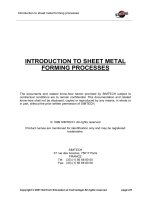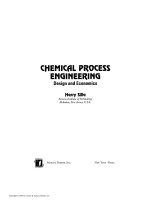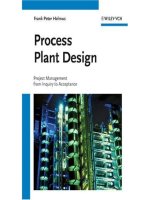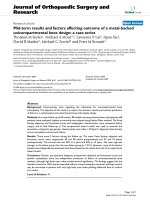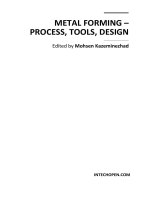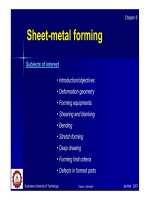METAL FORMING – PROCESS, TOOLS, DESIGN pps
Bạn đang xem bản rút gọn của tài liệu. Xem và tải ngay bản đầy đủ của tài liệu tại đây (17.94 MB, 218 trang )
METAL FORMING –
PROCESS, TOOLS, DESIGN
Edited by Mohsen Kazeminezhad
Metal Forming – Process, Tools, Design
Edited by Mohsen Kazeminezhad
Contributors
A. El Hami, B. Radi, A. Cherouat, Xin-Yun Wang, Jun-song Jin, Lei Deng, Qiu Zheng,
M. Bakhshi-Jooybari, A. Gorji, M. Elyasi, Bernd Engel, Johannes Buhl, Tetsuhide Shimizu,
Ming Yang, Ken-ichi Manabe, Marta Oliveira, Weizhong Guo, Feng Gao, Javier W. Signorelli,
María de los Angeles Bertinetti
Published by InTech
Janeza Trdine 9, 51000 Rijeka, Croatia
Copyright © 2012 InTech
All chapters are Open Access distributed under the Creative Commons Attribution 3.0 license,
which allows users to download, copy and build upon published articles even for commercial
purposes, as long as the author and publisher are properly credited, which ensures maximum
dissemination and a wider impact of our publications. After this work has been published by
InTech, authors have the right to republish it, in whole or part, in any publication of which they
are the author, and to make other personal use of the work. Any republication, referencing or
personal use of the work must explicitly identify the original source.
Notice
Statements and opinions expressed in the chapters are these of the individual contributors and
not necessarily those of the editors or publisher. No responsibility is accepted for the accuracy
of information contained in the published chapters. The publisher assumes no responsibility for
any damage or injury to persons or property arising out of the use of any materials,
instructions, methods or ideas contained in the book.
Publishing Process Manager Oliver Kurelic
Typesetting InTech Prepress, Novi Sad
Cover InTech Design Team
First published October, 2012
Printed in Croatia
A free online edition of this book is available at www.intechopen.com
Additional hard copies can be obtained from
Metal Forming – Process, Tools, Design, Edited by Mohsen Kazeminezhad
p. cm.
ISBN 978-953-51-0804-7
Contents
Preface VII
Section 1 Process 1
Chapter 1 Hydroforming Process: Identification of the Material’s
Characteristics and Reliability Analysis 3
A. El Hami, B. Radi and A. Cherouat
Chapter 2 Stamping-Forging Processing of Sheet Metal Parts 29
Xin-Yun Wang, Jun-song Jin, Lei Deng and Qiu Zheng
Chapter 3 Developments in Sheet Hydroforming
for Complex Industrial Parts 55
M. Bakhshi-Jooybari, A. Gorji and M. Elyasi
Chapter 4 Forming of Sandwich Sheets Considering
Changing Damping Properties 85
Bernd Engel and Johannes Buhl
Section 2 Tools 109
Chapter 5 Impact of Surface Topography of Tools
and Materials in Micro-Sheet Metal Forming 111
Tetsuhide Shimizu, Ming Yang and Ken-ichi Manabe
Chapter 6 Towards Benign Metal-Forming:
The Assessment of the Environmental Performance
of Metal-Sheet Forming Processes 135
Marta Oliveira
Section 3 Design 151
Chapter 7 The Design of a Programmable Metal
Forming Press and Its Ram Motion 153
Weizhong Guo and Feng Gao
Chapter 8 Self-Consistent Homogenization Methods
for Predicting Forming Limits of Sheet Metal 175
Javier W. Signorelli and María de los Angeles Bertinetti
Preface
In this book, different aspects of metal forming are considered. Three important
aspects are process, tools and design, which are sections names of the book.
Each section consists of different chapters. In each chapter, the efforts are focused on
presenting the state of art and also the new concepts and findings in
process/tools/design. In describing the concepts, the emphasis is on the analysis and
effect of materials characteristics.
The first section, named “Process”, consists of three chapters on hydroforming and
forging processes considering the analysis, production of complex parts and materials
characteristics. Another chapter of this section is focused on the forming of sandwich
sheets for controlling the damping properties.
The second one, i.e. “Tools” section, consists of two chapters. The chapters are related
to topography of tools and machine tools.
The third one is related to design of a programmable metal forming press and
methods for predicting forming limits of sheet metal. These designs can help the
economical production of industries.
Mohsen Kazeminezhad
Sharif University of Technology,
Iran
Section 1
Process
Chapter 1
© 2012 Hami et al., licensee InTech. This is an open access chapter distributed under the terms of the
Creative Commons Attribution License ( which permits
unrestricted use, distribution, and reproduction in any medium, provided the original work is properly cited.
Hydroforming Process: Identification of
the Material’s Characteristics and
Reliability Analysis
A. El Hami, B. Radi and A. Cherouat
Additional information is available at the end of the chapter
1. Introduction
The increasing application of hydroforming techniques in automotive and aerospace
industries is due to its advantages over classical processes as stamping or welding.
Particularly, tube hydroforming with various cross sectional shapes along the tube axis is a
well-known and wide used technology for mass production, due to the improvement in
computer controls and high pressure hydraulic systems (Asnafi et al., 2000; Hama et al,
2006; Cherouat et al., 2002). Many experimental studies of asymmetric hydroforming tube
have been examined (Donald et al., 2000; Sokolowski et al., 2000). Theoretical models have
been constructed to show the hydroforming limits, the material and the process parameters
influence on the formability of the tube without failure (buckling and fracture) (Sokolowski et
al.,2000). Due to the complexity of the process, theoretical studies up to date have produced
relatively limited results corresponding the failure prediction. As for many other metal or
sheet forming processes, the tendency of getting a more and more geometric complicated part
demands a systematic numerical simulation of the hydroforming processes. This allows
modifying virtually the process conditions in order to find the best process parameters for the
final product. Thus, it gives an efficient way to reduce cost and time.
Many studies have been devoted to the mechanical and numerical modelling of the
hydroforming processes using the finite element analysis (Hama et al., 2006; Donald et al.,
2000), allowing the prediction of the material flow and the contact boundary evolution
during the process. However, the main difficulty in many hydroforming processes is to find
the convenient control of the evolution of the applied internal pressure and axial forces
paths. This avoids the plastic flow localization leading to buckling or fracture of the tube
during the process. In fact, when a metallic material is formed by such processes, it
Metal Forming – Process, Tools, Design
4
experiences large plastic deformations, leading to the formation of high strain localization
zones and, consequently, to the onset of micro-defects or cracks. This damage initiation and
its evolution cause the loss of the formed piece and indicate that the forming process itself
should be modified to avoid the damage appearance (Cherouat et al.,2002). In principle, all
materials and alloys used for deep drawing or stamping can be used for hydroforming
applications as well (Koç et al,2002).
This chapter presents firstly a computational approach, based on a numerical and
experimental methodology to adequately study and simulate the hydroforming formability of
welded tube and sheet. The experimental study is dedicated to the identification of material
parameters using an optimization algorithm known as the Nelder-Mead simplex (Radi et
al.,2010) from the global measure of displacement and pressure expansion. Secondly, the
reliability analysis of the hydroforming process of WT is presented and the numerical results
are given to validate the adopted approach and to show the importance of this analysis.
2. Hydroforming process
For production of low-weight, high-energy absorbent, and cost-effective structural
automotive components, hydroforming is now considered the only method in many cases.
The principle of tube hydroforming is shown in Figure 1. The hydroforming operation is
either force-controlled (the axial forces vary with the internal pressure) or stroke-controlled
(the strokes vary with the internal pressure). Note that the axial force and the stroke are
strongly interrelated (see figure 1).
Force-controlled hydroforming is at the focus in (Asnafi et al.,2000), where the constructed
analytical models are used to show
• which are the limits during hydroforming,
• how different material and process parameters influence the loading path and the
forming result, and
• what an experimental investigation into hydroforming should focus on.
The hydroforming operation comprises two stages: free forming and calibration. The
portion of the deformation in which the tube expands without tool contact, is called free
forming. As soon as tool contact is established, the calibration starts.
Figure 1. The principle of tube hydroforming: (a) original tube shape and (b) final tube shape (before
unloading).
During calibration, no additional material is fed into the expansion zone by the axis
cylinders. The tube is forced to adopt the tool shape of the increasing internal pressure only.
Hydroforming Process: Identification of the Material’s Characteristics and Reliability Analysis
5
Many studies have been devoted to the mechanical and numerical modeling of the
hydroforming processes using the finite element analysis, allowing the prediction of the
material flow and the contact boundary evolution during the process. However, the main
difficulty in many hydroforming processes is to find the convenient control of the evolution
of the applied internal pressure and axial forces paths. This avoids the plastic flow
localization leading to buckling or fracture of the tube during the process. In fact, when a
metallic material is formed by such processes, it experiences large plastic deformations,
leading to the formation of high strain localization zones and, consequently, to the onset of
micro-defects or cracks. This damage initiation and its evolution cause the loss of the formed
piece and indicate that the forming process itself should be modified to avoid the damage
appearance. In principle, all materials and alloys used for deep drawing or stamping can be
used for hydroforming applications as well.
2.1. Mechanical characteristic of welded tube behaviour
Taking into account the ratio thickness/diameter of the tube, the radial stress is considerably
small compared to the circumferential
θ
σ and longitudinal stresses σ
z
(see Figure 2). In
addition, the principal axes of the stress tensor and the orthotropic axes are considered
coaxial. The transverse anisotropy assumption represented through the yield criterion can
be written as:
()
θθ
σ= σ−σ + σ+ σ
2
222
zz
FGH
(1)
with (F,G,H) are the parameters characterizing the current state of anisotropy.
If the circumferential direction is taken as a material reference, the anisotropy effect can be
characterized by a single coefficient R and the equation (1) becomes:
()
θθ
σ= σ−σ +σ+σ
+
2
222
zz
1
R
1R
(2)
The assumptions of normality and consistency lead to the following equations:
θθ
θ
ε
ε= σ− σ
σ+
ε
ε= σ− σ
σ+
z
zz
dR
d
1R
dR
d
1R
(3)
where
ε is the effective plastic strain and
()
θ
εε
z
,
are the strains in the circumferential and
the axial directions. The effective strain for anisotropic material can be derived from
equivalent plastic work definition, incompressibility condition, and the normality condition:
()
θθ θ
++
ε= ε+ε+ ε−ε =
γ
+
γ
+ε
+
++
2
22 2
zz
1R 2R 1R
dddRdd 1d
1R
12R 12R
with
θ
ε
γ=
ε
z
d
d
(4)
Metal Forming – Process, Tools, Design
6
Taking into account the relations expressing strain tensor increments, the equivalent stress
(Equation 2) becomes:
θ
+
σ= +
γ
+
γ
σ
+++
γ
2
2R 1 2R
1
1R 1RR
(5)
In the studied case, the tube ends are fixed. As a consequence, the longitudinal increment
strain ε=
z
d 0 , and then relations (4) and (5) become:
θθ
++ +
σ= σ ε= ε
+
+
2
3
2R 3R 1 1 R
dd
(1 R)
12R
(6)
The knowledge of the two unknown strain
θ
ε and stress
θ
σ needs the establishment of the
final geometric data linked to the tube (diameter and wall thickness):
θ
ε=
0
d
ln
d
and
θ
σ=
Pd
2t
(7)
where P is the internal pressure,
()
0
d,d
are the respective average values of the current and
initial diameter of the sample and (t) is the current wall thickness obtained according to the
following relation:
θ
−+
γ
ε
=
(1 )
0
tte
(8)
Finally, the material characteristics of the tube (base metal) are expressed by the effective
stress and effective strain according to the following equation (Swift model):
σ= ε +ε
n
0
K( )
(9)
The values of the strength coefficient
K, the strain hardening exponent n, the initial strain ε0
and the anisotropic coefficient R in Equations (2) and (9) are identified numerically. For the
determination of the stress–strain relationship using bulge test, the radial displacement, the
internal pressure and the thickness at the center of the tube are required.
Figure 2. Stress state at bulge tip
Hydroforming Process: Identification of the Material’s Characteristics and Reliability Analysis
7
3. Identification process
The parameters
()
0
K, ,nε
are computed in such a way that the constitutive equations
associated to the yield surface reproduce as well as possible the following characteristics of
the sheet metal. The problem which remains to be solved consists in finding the best
combination of the parameters damage which minimizes the difference between numerical
forecasts and experimental results. This minimization related to the differences between the
m experimental measurements of the tensions and their numerical forecasts conducted on
tensile specimens.
Due to the complexity of the used formulas, we have developed a numerical minimization
strategy based on the Nelder-Mead simplex method. The identification technique of the
material parameters is based on the coupling between the Nelder-Mead simplex method
(Matlab code) and the numerical simulation based finite element method via
ABAQUS/Explicit© of the hydroforming process. To obtain information from the output file
of the ABAQUS/Explicit©, we use a developed Python code (see Figure 3).
Figure 3. Identification process
4. Results and discussion
A three dimensional finite element analysis (FEA) has been performed using the finite
element code ABAQUS/Explicit to investigate the hydroforming processes.
Metal Forming – Process, Tools, Design
8
4.1. Tensile test
Rectangular specimens are made with the following geometric characteristics:
thickness=1.0mm, width=12.52mm and initial length=100mm, were cut from stainless
(Figure 4). All the numerical simulations were conducted under a controlled displacement
condition with the constant velocity v=0.1mm/s. The predicted force versus displacement
curves compared to the experimental results for the three studied orientations are shown in
Figure 1. With small ductility (Step 1) the maximum stress is about 360MPa reached for 25%
of plastic strain and the final fracture is obtained for 45% of plastic strain. With moderate
ductility (Step 3) the maximum stress is about 394MPa reached in 37.2% of plastic strain and
the final fracture is obtained for 53% of plastic strain. The best values of the material
parameters using optimization procedure are summarized in Table 1. Within these
coefficients the response (stress versus plastic strain) presents a non linear isotropic
hardening with a maximum stress σ=
max
279 MPa reached in
ε=
p
36.8%
of plastic strain
and the final fracture is obtained for 22 % of plastic strain. The plastic strain map of the
optimal case is presented in Figure 1.
Step Critical plastic strain K [MPa]
ε
0
n
1 25,8% 381,3 0.0100 0.2400
2 29,8% 395,5 0.0120 0.2415
3 37,2% 415,2 0.0150 0.2450
Optimal 36,8% 416,1 0.0198 0.2498
Table 1. Properties of the used material
Figure 4. Force/elongation for different optimization steps and plastic strain map
Hydroforming Process: Identification of the Material’s Characteristics and Reliability Analysis
9
4.2. Welded tube (WT) hydroforming process
In this case, the BM with geometrical singularities found in the WT is supposed orthotropic
transverse, whereas its behaviour is represented by Swift model. The optical microscope
observation on the cross section of the wall is used to build the geometrical profile of the
notch generated by the welded junction. By considering the assumptions relating to an
isotropic thin shell (R=1) with a uniform thickness, the previously established relations (6),
(7) and (9) allow to build the first experimental hardening model using measurements of
internal pressure/radial displacements. This model is then proposed, as initial solution, to
solve the inverse problem of required hardening law that minimizes the following objective
function:
=
−
ξ=
p
2
ii
m
exp num
F
i
i1
p
exp
FF
1
m
F
(10)
where
i
exp
F
is the experimental value of the thrust force corresponding to i
th
nanoindentation
depth H
i,
i
num
F
is the corresponding simulated thrust force and mp is the total number of
experimental points.
Different flow stress evolutions of isotropic hardening (initial, intermediate and optimal) are
proposed in order to estimate the best behavior of the BM with geometrical singularities
found in the WT. Figures 5 and 6 show the effective stress versus plastic strain curves and
the associate pressure/radial displacement for these three cases. As it can be seen, there is a
good correlation between the optimal evolution of Swift hardening and the experimental
results. Table 1 summarizes the parameters of these models.
Hardening model
ε
0
K (MPa) n
Initial 0.025 1124.6 0.2941
Intermediate 0.055 692.30 0.2101
Optimal 0.080 742.50 0.2359
Table 2. Swift parameters of different hardening evolution
The anisotropy factor R is determined only for the optimal hardening evolution. In the
problem to be solved there is only one parameter which initial solution exists, that it
corresponds to the case of isotropic material (R = 1). The numerical iterations were
performed on the WT with non-uniformity of the thickness (see Figure 7), and the obtained
results are shown in Figure 8. A good improvement in the quality of predicted results is
noted if R corresponds the value of 0.976.
Metal Forming – Process, Tools, Design
10
Figure 5. Stress-strain evolutions for different hardening laws
Figure 6. Internal pressure versus radial displacement
200
300
400
500
600
700
800
900
0 0,1 0,2 0,3 0,4
Effective plastic strain
Effective stress [MPa]
Initial
Inter mediate
Optimal
15
17
19
21
23
25
27
29
31
33
35
012345
Radial displacement [mm]
Internal pressure [MPa]
Experiment
Initial
Intermediate
Optimal
Hydroforming Process: Identification of the Material’s Characteristics and Reliability Analysis
11
Figure 7. Radial displacement for different values of anisotropy coefficient R
4.3. Thin sheet hydroforming process
Sheet metal forming examples will be presented in order to test the capability of the
proposed methodology to simulate thin sheet hydroforming operation using the fully
isotropic model concerning elasticity and plasticity (Cherouat et al.,2008). These results are
carried out on the circular part with a diameter of 300mm and thickness of 0.6mm. During
hydroforming of the blank sheet, the die shape keeps touching the blank, which prevents
the deformed area from further deformation and makes the deformation area move towards
the outside. The blank flange is drawn into the female die, which abates thinning
deformation of deformed area and aids the deformation of touching the female die and
uniformity of deformation. Compared with the experiments done before, the limit drawing
ratio of the blank is improved remarkably.
By considering the assumptions relating to an isotropic thin shell with a uniform thickness,
the previously established relations allow to build the first experimental hardening model
using measurements of force/displacement. This model is then proposed, as initial solution,
to solve the inverse problem of required hardening law that minimizes the following
objective function:
−
=
2
ii
m
exp num
error
i
1
exp
PP
1
E
m
P
(11)
where
i
exp
P
is the experimental value of the thrust pressure corresponding to i
th
displacement δ
i
,
i
num
P
is the corresponding predicted pressure and m is the total number of
experimental points.
20
22
24
26
28
30
32
0123 45
Radial displacement (mm)
Internal pressure (MPa)
Experiment
R=0,976
R=0,930
R=1,010
Metal Forming – Process, Tools, Design
12
The controlled process parameters are the internal fluid pressure applied to the sheet as a
uniformly distributed load to the sheet inner surface and is introduced as a linearly
increasing function of time with a constant flow from approximately 10 ml/min. The
comparator is used to measure the pole displacement. The effect of three die cavities (D1, D2
and D3 see Figure 8) on the plastic flow and damage localisation is investigated during sheet
hydroforming. These dies cavities are made of a succession of revolution surfaces (conical,
planes, spherical concave and convex). The evolution of displacement to the poles according
to the internal pressure during the forming test and sheet thicknesses are investigated
experimentally. The profiles of displacements are obtained starting from the deformations of
the sheet after bursting. Those are reconstituted using 3D scanner type Dr. Picza Roland of
an accuracy of 5μm with a step of regulated touch to 5mm. In addition, two measurement
techniques were used to evaluate the thinning of sheet after forming; namely a non-
destructive technique using an ultrasonic source of Sofranel mark (Model 26MG) and a
destructive technique using a digital micrometer calliper of Mitiyuta mark of precision
10μm (see Figure 9).
Figure 8. Geometry of die cavities (D1, D2 and D3)
Experiments results of circular sheet hydroforming are shown in Figure 10 (Die D1), Figure
11 (Die D2) and Figure 12 (Die D3). For the die cavities D1 and D3, fracture appeared at the
round corner (near the border areas between the conical and the hemispherical surfaces of
the die). For the die cavity D2, the fracture occurred at the centre of the blank when the
pressure is excessive. This shows that the critical deformation occurs at these regions. It is
noted that the rupture zone depends on the die overflow of the pressure medium from the
pressurized chamber and the reverse-bending effect on the die shoulder were not observed
in the experiment. In this part we are interested in the comparison between experimental
observations of regions where damage occurred and numerical predictions of areas covered
Hydroforming Process: Identification of the Material’s Characteristics and Reliability Analysis
13
by plastic instability and damage. Figures 10, 11 and 12 present as such, the main results and
simulations of all applications processed in this study. The predicted results with cavity dies
show that the equivalent von Mises stress reached critical values high and then subjected to
a significant decrease in damaged areas. This decrease is estimated for the three die cavities
D1, D2 and D3, respectively 29%, 14% and 36%.
Figure 9. 3D scanner G Scan for reconstitution
Comparisons between numerical predictions of damaged areas and the experimental
observations of fracture zones led us to the following findings:
1.
The numerical calculations show that increasing pressure, the growing regions marked by
a rise in the equivalent stress followed by a sudden decrease can be correlated with the
damaged zones observed experimentally. In this context, the results of the first die cavity
D1 show that instabilities are localized in the central zone of the blank, limited by a
circular contour of the radius 72mm. The largest decrease in stress is located in the area
bounded by two edges of respective radii 51 and 64mm. While the rupture occurred at the
border on the flat surface with the spherical one located on a circle of radius 60mm. With
the die cavity D2, the largest decrease is between two contours of radii 10 and 19mm, the
rupture is observed at a distance of 17mm from the revolution axis of deformed blank.
Finally with the die cavity D3, the calculations show that the damaged area is located in a
region bounded by two edges of respective radii 54 and 73mm, the rupture occurred in
the connection of the flat surface with the surface spherical one.
2.
The pressures that characterize the early instabilities are respectively the order of
4.90MPa (for D1), 2.85MPa (for D2) and 5.1MPa (for D3). For applications with die
cavities D1 and D3, regions where the beginnings of instability have been identified (see
Table 2).
The results presented in Fig. 9 show that the relative differences between predicted and
experiment results of pole displacement are in the limit of 7% while the pressure levels are
below a threshold characterizing the type of application.
Metal Forming – Process, Tools, Design
14
Figure 10. Experimental and numerical results of hydroforming using die cavity D1
Figure 11. Experimental and numerical results of hydroforming using die cavity D2
Hydroforming Process: Identification of the Material’s Characteristics and Reliability Analysis
15
Figure 12. Experimental and numerical results of hydroforming using die cavity D3
Figure 13. Pole displacement versus internal pressure
0
5
10
15
20
25
30
35
40
45
50
0 1234 56
Internal pressure (MPa)
Pole displacement (mm)
Exp eriment D1
Simulat io n D1
Exp eriment D2
Simulat io n D2
Exp eriment D3
Simulat io n D3
Metal Forming – Process, Tools, Design
16
Die cavit
y
Be
g
innin
g
instabilit
y
(MPa) Critical (MPa) Ex
p
erimental (MPa)
D1 4,90 6,74 5,2
D2 2,85 2,85 3,0
D3 5,10 6,86 5,3
Table 3. Levels of pressure for different dies
Figure 14. Optimisation of complex shape part
4.4. Optimization of sheet shape
Optimization is the action of obtaining the preferable results during the part design. In the
CAE-based application of optimization, several situations can cause the numerical noise
(wrinkling). When the numerical noise exists in the design analysis loop, it will create many
artificial local minimums. In this case, the minimization of local thinning condition in the
blank sheet metal was tested with a cost function of the optimization system was chosen to
minimize the thinning ratio of 20% thinnest element.
Hydroforming Process: Identification of the Material’s Characteristics and Reliability Analysis
17
i.e. Cost function:
=
−
=
2
n
0
i1
0
tt
f
t
where
0
t is the initial thickness and t the final thickness.
In this case a significant design variable for formability of blank during hydroforming
process and the design (D and d) constraints were defined:
≤≤ ≤≤50 D 250mm 20 d 100mm . The experimental final shape is shown in Figure 10a.
The comparison of the force versus the maximum displacement with the initial and
optimized blank shape is present in Figure 10b. Good agreement between the optimum
shape and the experimental values. Figures 10c and 10d compare the initial and the
optimum blank shape. Successfully decreased the cost function (thinning ratio) from 50% to
20% is obtained without wrinkling (Figure 10e and 10f) (see Ayadi et al.,2011).
5. Reliability analysis
Recently, RBDO has become a popular philosophy to solve different kind of problem. In this
part, we try to prove the ability of this strategy to optimize loading path in the case of THP
where different kind of nonlinearities exist (material, geometries and boundary conditions).
The aim of this study is to obtain a free defects part with a good thickness distribution,
decrease the risk of potential failures and to let the process insensitive to the input
parameters variations. For more detailed description of the RBDO methodology and variety
of frameworks the reader can be refer to the following references (Youn et al., 2003;
Enevoldsen et al., 1994; El Hami et al., 2011). The RBDO problem can be generally
formulated as:
()
()
()
≤−Φ−β≤=
≤≤ ∈ ∈
i
it
LUndv nrv
Min f d,X
subject to P G d,X 0 0 i 1, ,np
d d d , d R and X R
(12)
where f(d,X) is the objective function, d is the design vector, X is the random vector, and the
probabilistic constraints is described by the performance function G
i(X), np, ndv and nrv are
the number of probabilistic constraints, design variables and random variables, respectively,
β
ti is the prescribed confidence level which can be defined as
()
−
β=−Φ
i
1
tf
P
where
f
P is the
probability of failure and
Φ
is the cumulative distribution function for standard normal
distribution.
The process failure state is characterized by a limit state function or performance function
G(X), and G(X)=0 denotes the limit state surface. The m-dimensional uncertainty space in
thus divided into a safe region
()
}
{
()
Ω= >
s
X:G X 0
and a failure region
()
}
{
()
Ω= ≤
f
X:G X 0
(see Radi et al.,2007).
